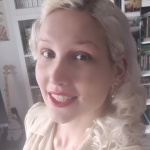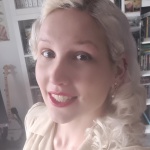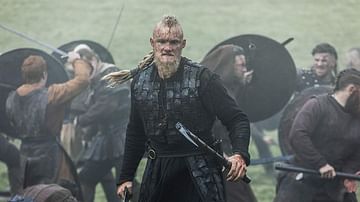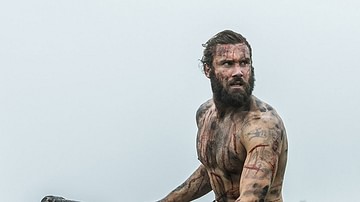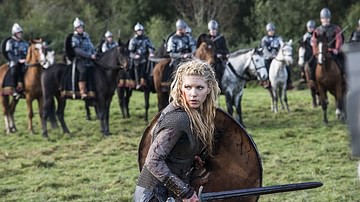
Ivar the Boneless (Old Norse Ívarr hinn Beinlausi) is known from Old Norse and medieval Latin sources as the son of the legendary Viking king Ragnar Lothbrok, in these stories raiding alongside his father and brothers and becoming the ruler of York in England in the 9th century CE. His epithet is the unfortunate result of Ragnar's eagerness on his wedding night with Aslaug, who had to no avail cautioned him to wait three nights before consummating their marriage lest the son they conceived should be born with no bones. What exactly Ivar's bonelessness entails is hard to envision – we get the impression of weak- or brittle bones or literally no bones, at least in his legs – but either way, Ivar is carried everywhere on a stretcher or shield. He is famed for his cleverness and strategical insight and is generally shown as the leader of his band of brothers on their adventures. The popular TV series Vikings, in which Ivar is portrayed by Alex Høgh Andersen, echoes this trait and shows him as a brilliant tactician, too; he is here moreover hauled around in a cart due to his disability and is depicted as a cruel and ruthless spoiled brat who becomes a bit of a sociopath, killing his brother Sigurd Snake-in-the-Eye in a fit of rage (all creative license).
Part of a famous legendary family whose exact members vary depending on which source you are reading, besides parents Ragnar and Aslaug (or, in the 13th-century CE Gesta Danorum, Thora) the Ivar of the medieval legends is often seen alongside brothers Bjorn Ironside, Hvitserk, and Sigurd Snake-in-the-Eye. Ivar is sometimes equated with a historical Ivar ('Hingwar') who seems to have been one of the leaders of the Viking Great Army which landed in England in 865 CE, and/or a certain Viking leader named Ímar connected with Viking Dublin between 853-873 CE. However, there are many problems with such a direct identification. As with the larger-than-life Ragnar Lothbrok, though, it is possible that figures who left their stamp on 9th-century CE Viking activities may have helped inspire the later (c. 13th-century) legends, reshuffled and tailored to the authors' own purposes.
The Saga of Ragnar Lothbrok
With Ivar the Boneless only appearing within the Ragnar Lothbrok mythos, the starting point for his deeds must be its best-known and main source: the 13th-century Icelandic The Saga of Ragnar Lothbrok (Old Norse: Ragnars saga loðbrókar). It kicks off with the childhood of Aslaug, who will go on to become Ragnar's second wife and mother of Ivar. She is the daughter of Sigurd and Brynhild (the legendary dragonslayer and the Valkyrie from Germanic mythology further popularised by Wagner), who die when she is three years old. Thus, she grows up in Norway taken in by a poor family who name her Kráka ('crow') and keep her parentage hidden. Meanwhile, Ragnar, son of King Sigurd Ring of Denmark, meets his first wife Thora after ridding her town in Götaland from its dragon-problem. With her, Ragnar has two sons, Ivar's older half-brothers Eirek and Agnar.
After Thora's untimely death Ragnar encounters Kráka while raiding in Norway, and marries her despite her seemingly poor heritage. Although Kráka tells him she has been cursed to give birth to a son with no bones if her husband proved too impatient on her wedding night (rather than waiting three nights), Ragnar cannot control himself. Thus, nine months later Ivar the Boneless is born:
…the boy was boneless, as if there were gristle where his bones should be. When he was young, he was grown so large that no one was his equal. He was the handsomest of all men, and so wise that it wasn't certain whether there had ever been a wiser man than him. (7).
So, despite Ivar's inconvenient condition, the situation could have been much worse. More sons are born to Ragnar and Kráka: Bjorn Ironside, Hvitserk, and Rognvald (and, at a later point, Sigurd Snake-in-the-Eye), who all grow up to be great men and bold warriors. Often going raiding together, the brothers are led by Ivar who is carried on a stretcher or shield and shows a true talent for planning and strategy. He is also (somehow) adept at using a bow.
In fact, his upper body seems to have an extraordinary strength, despite his bonelessness, at least in this particular saga. When meeting King Eystein of Sweden in battle, who had a magical cow named Sibilja at his side who wreaked havoc on his opponents, Ivar steps up. He orders his men to create a massive bow out of a large tree, and from his shield he 'drew his bow as if it were a flimsy elm twig' (12), shooting an unfortunate Sibilja right in her eyes. Sibilja then goes on a rampage and Ivar is tossed at her by his men, crushing her completely. Ivar clearly has special powers; after being picked up again, his voice pierces across the whole battlefield, reaching each warrior as if he were standing right next to them, motivating them. As such, the sons of Ragnar achieve victory.
Towards the end of this saga, after boasting he will invade England with just two ships, Ragnar is captured by King Ælla of Northumbria (r. c. 866 CE) and thrown into a snake-pit, where he dies. Ragnar's sons then avenge their father by sailing to England and allegedly torturing Ælla by performing the blood-eagle on him (see below).
The Tale of Ragnar's Sons
This story, along with most of the main elements of The Saga of Ragnar Lothbrok, is also preserved in the late 13th-early 14th century CE Icelandic work, The Tale of Ragnar's Sons (Ragnarssona þáttr). Ivar, again, is the leader of his little band of brothers, who here also go against their father's will here and there going off into certain territories because they want to be just as famous as him. In one such instance where Ivar and co. go rogue, Ragnar sets up Eystein Beli as King over Upper Sweden and asks him to guard the realm from his sons if they try to claim it. Eirek and Agnar attempt this but are killed, inspiring their half-brothers and step-mother Aslaug to avenge them without waiting for Ragnar.
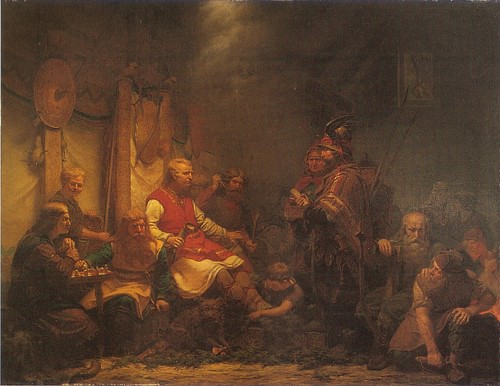
With the Sweden story concluded, just like in The Saga of Ragnar Lothbrok Ragnar then sails to England with only two ships and perishes at the hand (well, fangs) of snakes in King Ælla's Northumbria. When his sons sail to England seeking retribution, The Tale of Ragnar's Sons states that Ivar the Boneless refuses to fight, and the brothers are defeated by a much larger host and go home. Ivar, however, stays in England – he has hatched a cunning plan. Going to see Ælla and making the case that he had not joined the fight against him, Ælla agrees to compensate him for his father's death and will give him as much land as he can cover with the biggest bull-hide he can find. Ivar stretches the hide immensely, cuts it into thin strips and covers a much larger territory than intended. Founding the city of York there, Ivar spends his time forging local connections before inviting his brothers to cross the pond, once more, and exact their vengeance on Ælla. With Ivar's new friends aiding them, and Ælla thinking Ivar is on his side, they defeat Ælla and torture him: 'They now had the eagle cut in Ella's back, then all his ribs severed from the backbone with a sword, in such a way that his lungs were pulled out there.' (3). Luckily for Ælla, this method is thought to be fictitious and the stuff of these legends, only.
Ivar remains a local king in England for a long time after, ruling from York but having no children to succeed him, 'because of the way he was: with no lust or love' (4). It has been suggested that rather than this sentence indicating that Ivar's physical problems also prevented him from having intercourse, perhaps his 'bonelessness' did not so much entail skeletal problems at all but rather that he could not perform. Either way, Ivar is here described to have died in England of old age. The Tale then proceeds to tell lengthy (and tall) stories of the various exploits of Ivar's remaining brothers.
Ivar in the Gesta Danorum
Although there are some other medieval Latin sources who mention Ragnar and, in passing and not necessarily by name, his sons, the main Latin source in which we also find Ivar at length is the Gesta Danorum ('Deeds of the Danes'). Probably written in the early 13th century CE, by Saxo Grammaticus, the Gesta introduces some new characters and events unreported by other sources. One explanation for this apparent mishmash is that Saxo may have been trying to reconcile various versions of stories he had heard or read elsewhere into one account. Among others, two wives of Ragnar not mentioned anywhere else appear in the Gesta: the shieldmaiden Lagertha and a woman named Swanloga.
A crucial difference between Saxo's work and the Saga and Tale discussed above is that Aslaug is wholly absent, creating a slight parenting issue for Ivar, who is normally depicted as her son. Although he does not explicitly say so, when talking about Ragnar and Thora getting together Saxo seems to imply Ivar (here Iwar) is her son: 'By her he begot two nobly-gifted sons, Radbard and Dunwat. These also had brothers—Siward, Biorn, Agnar, and Iwar.' (9). Siward corresponds with Sigurd (Snake-in-the-Eye) and Biorn with Bjorn Ironside, while Radbard and Dunwat are wildcards. In another twist, Saxo makes no mention at all of Ivar being boneless, perhaps dismissing it as a far too impractical fantasy.
In the Gesta, Ivar is shown as a wise and respectful person worthy of his father's trust, fitting in with the overall vibe one gets from the other legends. While one of Ragnar's other sons, Ubba (here spelt Ubbe) plans to usurp his father, Ivar, at this point the governor of Jutland in Denmark, avoids the conflict by voluntary exile. This earns him his father's praise, and Ragnar later puts Ivar in charge of his kingdom while he is away. Subsequently, the King Ælla story unfolds, with Ivar helping his father on his initial trip to York and later hearing of Ragnar's death by the familiar route. The boar-hide trick is preserved here, too, laying the foundations for Ivar's two-year rule in England. He then settles in Denmark, choosing his brother Agnar to keep an eye on England. This is the last we hear of Ivar in this tale.

Historicity
Leaving aside the fact that a person who was quite literally boneless is unlikely to have made the history books as a famous Viking raider (or even to have survived past birth in those days), let us look at the question of whether Ivar, son of Ragnar, has some basis in historical reality. A word of caution in this examination comes from the time-gap between the sources and their subject matter; most of the Ragnar sagas spring up from the 12th century CE onwards and are clearly legendary in nature, while the deeds they describe take place in the 9th century CE. This century, moreover, is not exactly a goldmine when it comes to coverage by historical sources, either, so stories can be hard to verify. Add to that the fact that many Viking names were quite common, so finding a certain 'Ivar' in two separate sources does not at all guarantee you will take home the prize money when claiming it is the same person.
For starters, certain events and persons that appear in the Ivar legends are actually historical. King Ælla of Northumbria really existed and reigned around 866 CE, and he witnessed a Viking 'Great Army' harrying the Anglo-Saxon kingdoms from 865 CE onwards. Ælla's historical death is said to have occurred in battle with Viking forces at York in 867 CE (but no mention is made of the gruesome blood-eagle torture method perpetuated by the Ragnar legend). Such elements thus seemingly made it into the later sagas, in altered form.
When it comes to chasing down Ivar, specifically, the Anglo-Saxon Chronicle actually mentions a 'Hingwar' and 'Hubba' as chieftains of this Viking 'Great Army', as well as a certain 'Halfdene' (Anglo-Saxon Chronicle for 870 & 871 CE). They have often been connected with Ivar the Boneless and Ubba - with 'Halfdene' or Halfdan possibly representing the Hvitserk of the Old Norse tradition. Later English sources add some more titbits but probably not with a proper historical basis. Besides Hingwar, other spellings that crop up are Inguar, Ingwar, Igwar, or Iuuar, linked to an early Danish form of Ivar.
On the other side of the Irish Sea, in 9th-century CE Viking Dublin, we find another figure that is often dragged into the Ivar-discussion. A certain Viking leader called Ímar (or Imhar, pronounced like Ivar) pops up time and again in the contemporary Irish annals, wreaking havoc across the country and getting tangled up in the northern Irish Sea region's politics from 853 CE until his death in 873 CE.
It has proved irresistibly attractive to many to see both of these Ivars – the one active in England and the one active in Ireland – as one and the same person. As scholar Donnchadh Ó Corráin sees it, the evidence in favour of this consists firstly of the similarity of the names; secondly of the fact that Ímar is not mentioned in the Irish annals between 864-870 CE (so, perhaps he was elsewhere – in England?); and thirdly of the fact that after this time, the dynasties of Dublin and of York became closely connected. York, besides being the site of Ælla's historical death, is of course also Ivar the Boneless' seat in the later legends. However, Ó Corráin continues, these above points are not all that much to go on. The contemporary material that does mention an Ivar in England is very scarce, and the little we do have appears to contradict itself. Moreover, just because someone is not mentioned in Irish annals for a while does not tell you where they were or what they were doing. He concludes: 'though the identifications are attractive, very serious difficulties lie in their way and until these are removed we must remain in doubt.' (323).
If the Ivar the Boneless of the later sagas was directly based on historical Vikings, the above two appear to be the prime candidates. Many things caution against seeing them as copy-pasted figures, though, as a lot of the details differ between the legends and history. For starters, Ivar's supposed father, Ragnar Lothbrok, was probably not directly historical but was rather based on multiple figures tied together into one larger-than-life character, serving a literary purpose. Whoever inspired Ragnar, moreover, is in no traceable way connected with the historical Hingwar/Ímar. As far as we know the Viking invasion of Anglo-Saxon England in 865 CE had nothing to do with avenging anyone's father either, like it does in the sagas. However, the 9th-century CE setting of the story of Ivar the Boneless clearly draws from reality. It is not hard to imagine, either, how the deeds of such real Vikings as Hingwar and/or Ímar may have, far down the line, inspired the Ivar the Boneless of the legends, there taking on greatly embellished and tailored proportions but with roots in 9th-century CE history.
